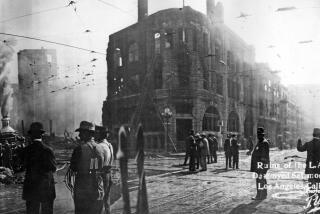A SUNDAY IN DECEMBER : War Casualties and The Destruction of Japan
- Share via
Responsibility for the all-out, U.S. government-sponsored research effort that produced the first atomic bomb was assigned Aug. 13, 1942, to the Manhattan Engineer District of the Army Corps of Engineers. And from then on, the entire effort was known as the Manhattan Project.
By Dec. 2, 1942, a laboratory at the University of Chicago, under Enrico Fermi’s direction, initiated the first self-sustaining chain reaction using an experimental uranium and graphite atomic pile. The atomic age had begun.
A test bomb was successfully exploded near Alamogordo, N.M., on July 16, 1945, and on Aug. 6, 1945--a week shy of three years after the Manhattan Project was launched--the first atomic bomb was exploded over Hiroshima, Japan.
Dubbed “Little Boy,” the atomic bomb that exploded over Hiroshima at 8:15 a.m. Aug. 6, 1945, destroyed nearly everything within a 1.5-mile radius and caused enormous damage beyond.
Although the exact tolls of the Hiroshima atomic attack and the atomic bombing of Nagasaki three days later are still uncertain, about 70,000 people in Hiroshima and 20,000 in Nagasaki are believed to have died almost instantly. Within five years, well over 200,000 more had died from injuries and exposure to radiation.
Japan surrendered Aug. 14, 1945.
Combatants and Casualties
Pacific Theater Pacific Theater Men Under Arms Military Casualties Casualties As % of Country At Peak (Dead and Wounded) Worldwide Total United States 12,364,000 296,000 27.6% Japan 6,095,000 1,435,000* 100.0% China 5,000,000 3,086,000 100.0% Britain 4,683,000 90,000 11.9% India 2,150,000 85,000 84.6% Australia & 837,000 30,000 29.7% New Zealand Totals: 31,139,000 5,022,000
*Japanese Defance Agency archives indicate a higher toll--1,858,811 military and 658,595 civilian dead in teh war.
SOURCE: The Pacific War, 1941-1945, by John Costello.
The ‘Enola Gay’ B-29 Superfortress
* The B-29 that dropped the first atomic bomb was named by its pilot, Paul Tibbets, after his mother--Enola Gay Tibbets.
* Forty-six years later, the aircraft that became the symbol of the start of the nuclear age is still being restored at the Smithsonian Institute’s Garber Facility in Silver Hill, Md. It is expected to be ready for public display about 1995.
U.S. Atomic Bombs
* Little Boy: Dropped on Hiroshima August 6, 1945 Diameter: 2 ft. 4 in. Length: 10 ft. Weight: 9,000 lbs. Charge: Uranium 235, detonated with a force of 20,000 tons of TNT.
* Fat Man: Dropped on Nagasakei August 9, 1945 Diameter: 5 ft. Length: 10 ft. 8 in. Weight: 10,000 lbs. Charge: Plutonium 230
Percentage of Japanese Cities Destroyed by Allied Air Attacks Moji: 23% Yawata: 22% Sasebo: 41% Shimonoseki: 38% Fukui: 85% Ube: 21% HIROSHIMA: 42% Osaka: 35% Kobe: 56% Kure: 42% Kochi: 55% Matsuyama: 64% Uwajima: 54% Fukuoka: 24% Omuta: 36% Miyazaki: 26% Miyakonojo: 27% Kagoshima: 63% NAGASAKI: 26% Sakai: 48% Aomori: 30% Maebashi: 64% Nagaoka: 65% Kofu: 79% Toyama: 96% Wakayama: 50% Utsunomiya: 44% Sendai: 22% Hitachi: 72% Mito: 69% Choshi: 44% Chiba: 41% TOKYO: 40% Yokohama: 58% Nagoya: 40% Tsu: 69% Uji Yamada (now known as Ise): 41%
More to Read
Sign up for Essential California
The most important California stories and recommendations in your inbox every morning.
You may occasionally receive promotional content from the Los Angeles Times.










